PANDA2 finds minimum weight designs of laminated composite flat or curved cylindrical panels or cylindrical shells with stiffeners in one or two orthogonal directions. The panels or shells can be loaded by as many as five combinations of in-plane loads and normal pressure. Constraints on the design include crippling, local and general buckling, maximum tensile or compressive stress along the fibers and normal to the fibers in each lamina, and maximum in-plane shear stress in each lamina. Local and general buckling loads are calculated with the use of either closed-form expressions or discretized models of panel cross sections.
An analysis branch exists in which local post buckling of the panel skin and stringers are accounted for, meaning that the panel can be intentionally optimized to permit local buckling at a load less than the design load. In this branch a constraint condition that prevents stiffener pop-off is introduced into the optimization calculations.
The PANDA2 system includes two processors, PANEL and PANEL2, that can be used to create valid input files for BIGBOSOR4, and a processor, STAGSUNIT, that can be used to create valid input files for STAGS. Therefore, an optimum design first obtained by PANDA2 can be evaluated rather easily by then running BIGBOSOR4 and/or STAGS with automatically-generated valid input data corresponding to the optimized design developed by PANDA2.
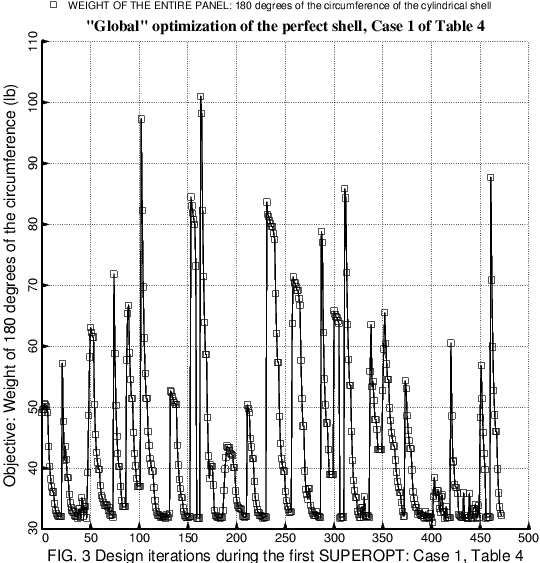
Graphic from AIAA 48th Structures, Structural Dynamics, and Materials Conference, Paper no. AIAA-2007-2216, 2007.
Design iterations during an execution of SUPEROPT, a PANDA2 processor the purpose of which is to seek a “global” optimum design. Each “spike” in the plot corresponds to a new starting design, which (as explained in [1D, 1K]) is generated randomly in a manner consistent with all linking and inequality constraints. See Table 3 for a typical PANDA2 runstream that includes several executions of SUPEROPT.
For a gallery of the kind of problem that can be solved by PANDA2, see the following three slide shows: Slide Show (1987-1995), Slide Show (1996-1999), and Slide Show (2002-2007). These three slide shows are primarily composed of pictures taken from the long, illustrated abstracts of papers about PANDA2 and results generated from executions of PANDA2 with verification of optimum designs produced by PANDA2 via execution of STAGS.
Abstracts and Papers (1987-1995)
-
PANDA2 – A Program for Minimum Weight Design of Stiffened, Composite, Locally Buckled Panels, David Bushnell, Lockheed Palo Alto Research Laboratory, 3251 Hanover Street, Palo Alto, California 94304 USA. Computers & Structures, Vol. 25. No. 4 pp. 469-605, 1987.
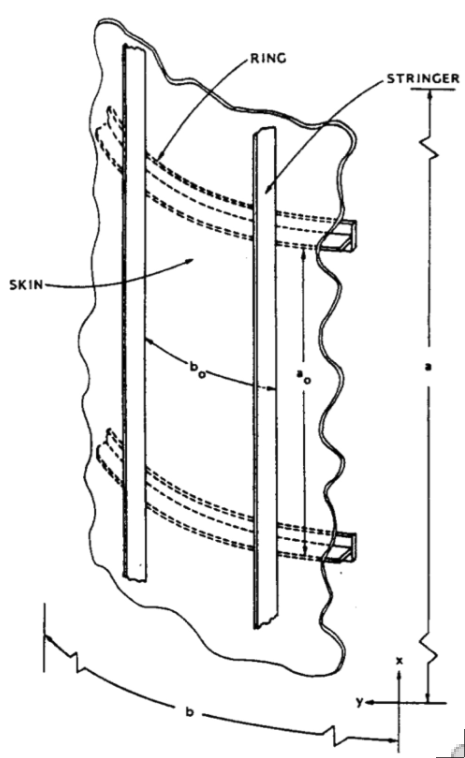
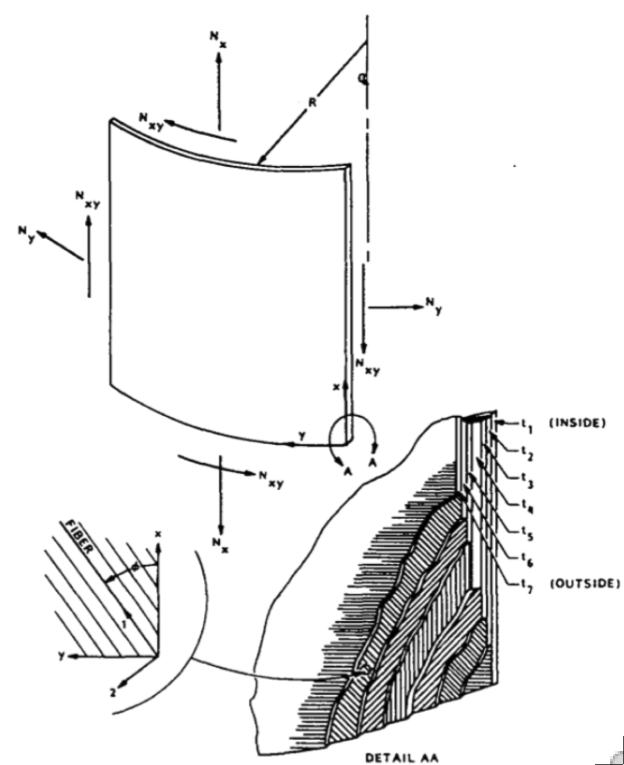
Left: Stiffened cylindrical panel with overall dimensions (a,b), ring spacing (ao) and stringer spacing (bo); Right: Coordinates, loading, and wall construction.
PANDA2 finds minimum weight designs of laminated composite flat or curved cylindrical panels or cylindrical shells with stiffeners in one or two orthogonal directions. The panels or shells can be loaded by as many as five combinations of in-plane loads and normal pressure. Constraints on the design include crippling, local and general buckling, maximum tensile or compressive stress along the fibers and normal to the fibers in each lamina, and maximum in-plane shear stress in each lamina. Local and general buckling loads are calculated with the use of either closed-form expressions or discretized models of panel cross sections. An analysis branch exists in which local post buckling of the panel skin is accounted for. In this branch a constraint condition that prevents stiffener popoff is introduced into the optimization calculations. Much of this paper represents a tutorial run through the PANDA2 processors for a hat-stiffened panel under combined axial compression, in-plane shear and normal pressure. Examples follow in which results from PANDA2 are compared with those in the literature and those obtained with the STAGS and EAL computer programs. Results of an extensive study are given for an optimized, blade-stiffened panel design so that it buckles locally at about 10% of the design load. The axially stiffened panel is subjected to pure axial compression, pure normal pressure, combined axial compression and normal pressure, and combined axial compression and residual stresses and deformations that arise from a simulated curing process. An example is provided of a design process applied to a ring and stringer stiffened cylindrical shell similar in geometry and loading to the 2/3 inter-stage of the ARIANE 4 booster.
-
Theoretical Basis of the Panda Computer Program for Preliminary Design of Stiffened Panels Under Combined In-Plane Loads, David Bushnell, Lockheed Palo Alto Research Laboratory, 3251 Hanover Street, Palo Alto, California 94304 USA. Computers & Structures, Vol. 27, No. 4, pp. 541-563, 1987.

This is Equation No. 57 from this paper. The various quantities on the right-hand side of the equation are defined in the 1987 PANDA paper, which can be downloaded from this website. This is the so-called "PANDA-type" (closed form) buckling model, which is frequently referred to as "PANDA-type model" in the PANDA2 literature.
A theory based on minimum potential energy for the bifurcation buckling of elastic or elastic-plastic isotropic or elastic composite, flat or cylindrical, ring- and stringer-stiffened panels subjected to combined in-plane loads is derived. Equations are given for general instability, panel instability and local instability of panels with fully populated 6 x 6 thickness-integrated constitutive matrices. Also derived are equations for crippling and rolling of stiffeners. The theory has been implemented in user-friendly, interactive computer programs called PANDA and PANDA2 for the minimum-weight design of panels. These programs have been described in previous papers. (2011 NOTE: The original PANDA program is no longer maintained or distributed. It has been superseded by PANDA2. As part of its collection of solutions of buckling problems, PANDA2 includes the PANDA formulas. However, PANDA2 also includes many other more elaborate buckling models, as described in other papers on PANDA2.)
-
Optimization of a Tee-Stiffened Panel Under Axial Compression, In-Plane Shear, And Normal Pressure, David Bushnell, Lockheed Palo Alto Research Laboratory, 3251 Hanover Street, Palo Alto, California 94304 USA. AIAA 32nd Structures, Structural Dynamics and Materials Conference, AIAA Paper 91-1207-CP, 1991.
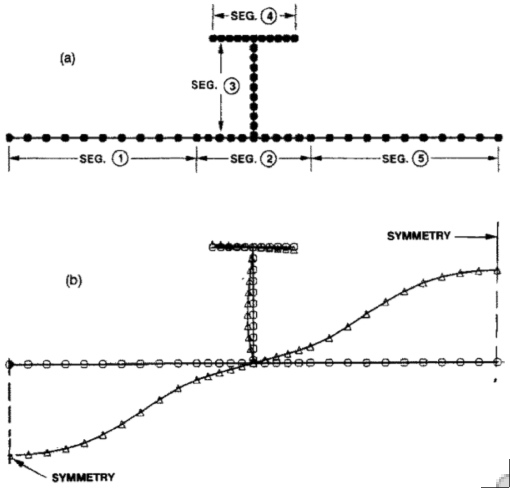
A single skin-T-stringer module: (a) Discretized model of a tee-stiffened module with (b) a local bifurcation buckling mode. Model (b) is used by PANDA2 to determine local post-buckling behavior and stiffener pop-off. Discretization of the module cross section is the same as that used in the BOSOR4 code: The "meridian" (arc length along each segment of the skin-stringer cross section) is discretized, and variation of the buckling modal displacements normal to the plane of the screen is trigonometric with m axial half-waves (strip method). The critical local buckling mode is found by searching over a range of m established by PANDA2 automatically or specified by the PANDA2 user.
The PANDA2 computer program is used to find a minimum weight design of a flat panel with T-shaped stringers. The panel is allowed to buckle locally under the specified loading. The evolution of the design is influenced by stress and buckling constraint conditions at the mid-length and at the ends of the panel. These constraint conditions are very different because bending of the panel under the pressure gives rise to very different distributions of stress over the cross section of skin and stringers that cause different buckling and post-buckling behaviors at these locations.
-
Optimization of composite, stiffened, imperfect panels under combined loads for service in the postbuckling regime, David Bushnell, Lockheed Palo Alto Research Laboratory, 3251 Hanover Street, Palo Alto, California 94304 USA. Computer Methods in Applied Mechanics and Engineering, 103 (1993) 43-114 North-Holland.
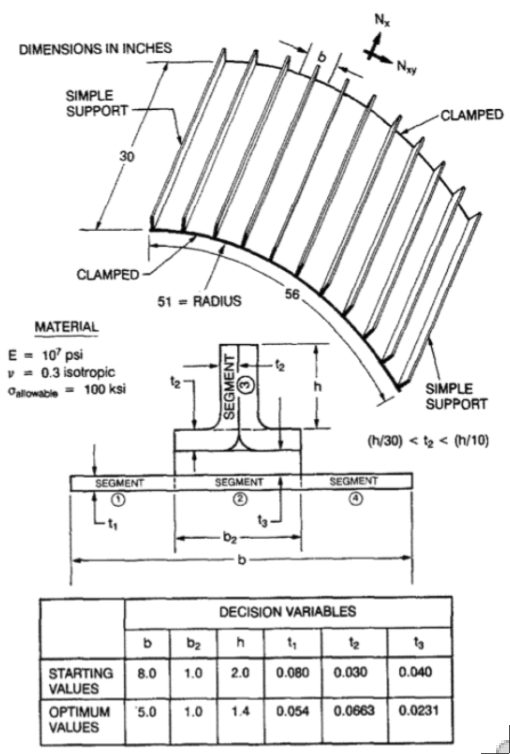
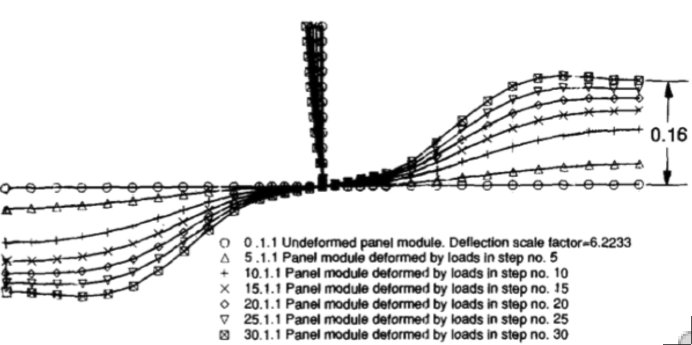
Left: Externally blade-stiffened cylindrical panel and the decision variables used for optimization by PANDA2. Right: PANDA2 prediction of deformation of an optimized cross section of a single locally post-buckled panel module for Load Set No. 1 with axial load Nx = 0., -1000, -2000, -3000, -4000, -5000, -6000 lb/in.
Local buckling and post-buckling of panels stiffened by stringers and rings and subjected to combined in-plane loads are explored with the use of a single module model that consists of one stringer and a width of panel skin equal to the stringer spacing. The cross-section of the skin-stringer module is discretized and the displacement field is assumed to vary trigonometrically in the axial direction. Local imperfections in the form of local buckling modes and overall initial axial bowing of the panel are included in the numerical model. The local post-buckling theory, based on early work of Koiter, is formulated in terms of buckling modal coefficients derived from integrals of products of the discretized displacement field and its derivatives. The principle of minimum potential energy is used to derive nonlinear algebraic equilibrium equations in terms of four unknowns, the amplitude f of the post-buckling displacement field, a post-buckling 'flattening' parameter a, the slope m of the nodal lines in the post-buckling displacement field, and an axial wavelength parameter N. The nonlinear equations are solved by Newton's method. An elaborate strategy is introduced in which the incidence of non-convergence is minimized by removal and re-introduction of the unknowns f, a, m, N on a one-by-one basis. This nonlinear theory has been implemented in the PANDA2 computer program, which finds minimum-weight designs of stiffened panels made of composite materials. PANDA2 is used to find the minimum weight of a cylindrical panel made of isotropic material with rectangular stringers mounted on thickened bases. The panel is optimized for three load sets, axial compression with negative axial bowing, axial compression with positive axial bowing, and combined axial compression and in-plane shear with no axial bowing. The optimum design is loaded well beyond local buckling for each load set. Critical margins of the optimized design include maximum allowable effective stress, bending-torsion buckling and general instability. The optimum design is evaluated by application of a general-purpose finite element program, STAGS, to finite element models generated by PANDA2 for each of the three load sets. The agreement of results between PANDA2 and STAGS is good enough to qualify PANDA2 as a preliminary design tool.
-
Minimum-Weight Design of a Stiffened Panel Via Panda2 and Evaluation of the Optimized Panel Via STAGS, D. Bushnell and W. D. Bushnell, Department 93-30, Building 251, Lockheed Palo Alto Research Laboratory, 3251 Hanover St., Palo Alto, CA 94304 USA. Computers & Structures, Vol. 50, No. 4, pp. 569 – 602, 1994, and Computers & Structures, Vol. 55, No. 5, pp. 819 – 856, 1995.
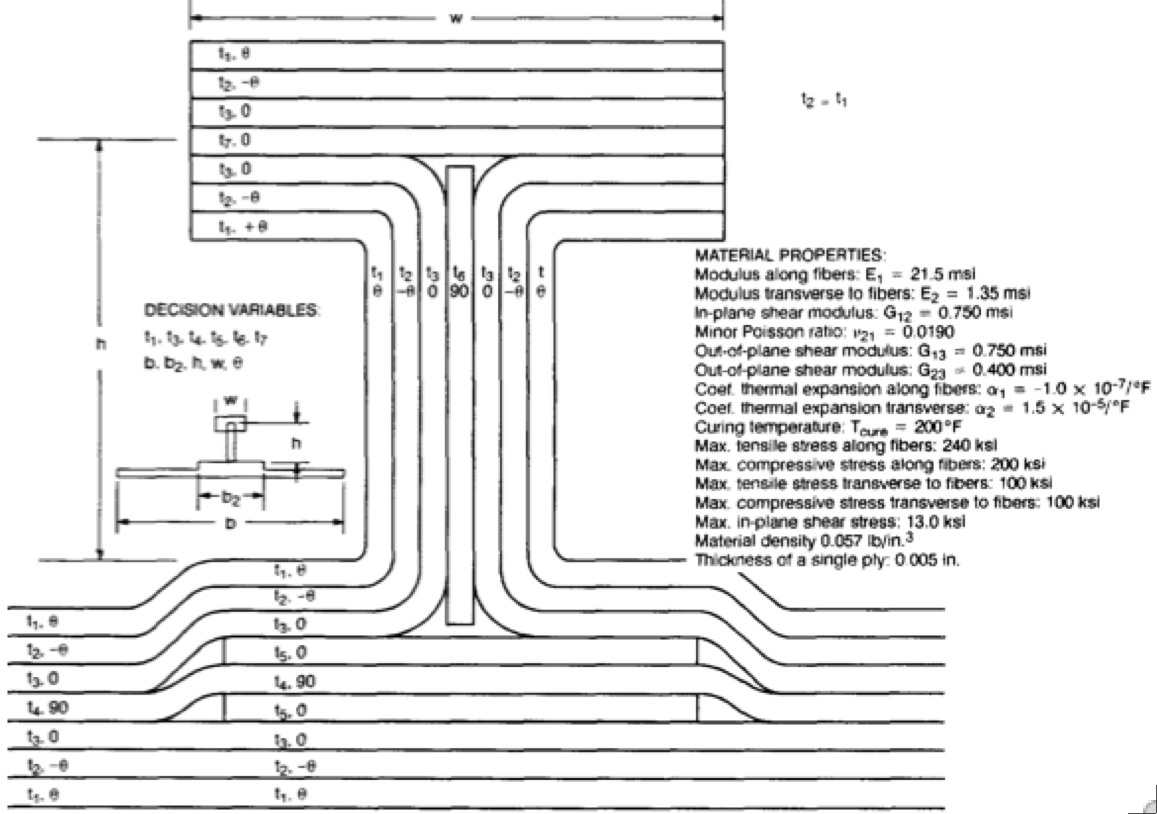
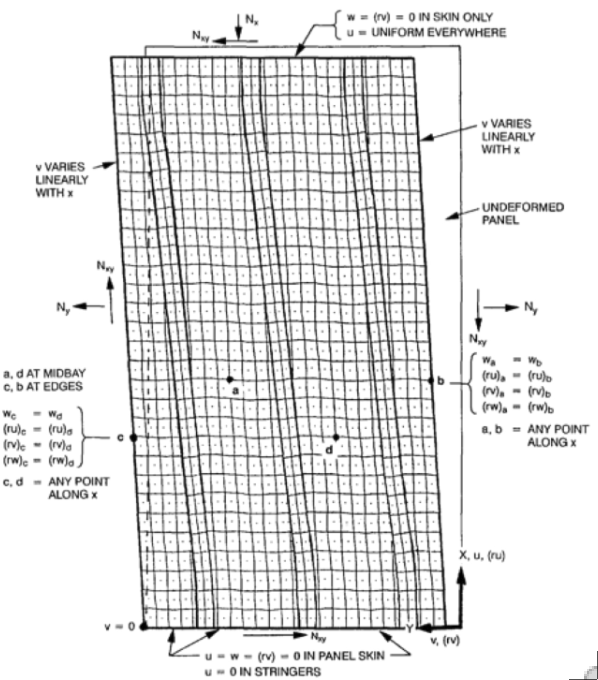
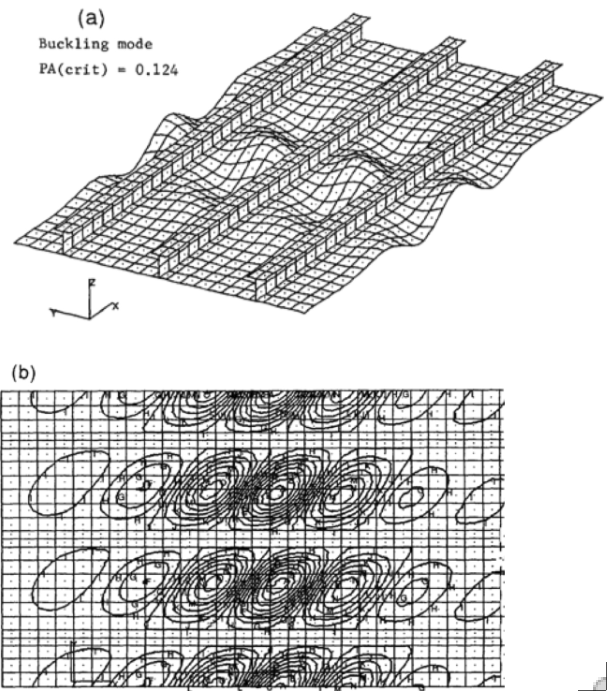
Top: An example of a T-stiffened panel module made of laminated composite material with layup in the various segments of the single skin-stringer module, geometry, decision variables, and material properties in the T-stiffened panel under combined loads. The panel can be loaded far into its local post-buckling regime. Left: Plan view of undeformed and deformed STAGS finite element model of the T-stiffened panel previously optimized by PANDA2 for service in the far post-buckling regime. The in-plane loading components, Nx and Nxy, are shown as well as the boundary conditions for the case in which the two edges parallel to the stringers (longitudinal edges) are prevented from warping in the plane of the panel skin. Right: STAGS prediction of the critical buckling mode and load factor from linear bifurcation buckling theory. This mode shape is used as an initial imperfection in the nonlinear equilibrium STAGS analysis to follow.
A minimum-weight design of a T-stiffened panel is found with the PANDA2 program. The panel, subjected to axial compression, in-plane shear, and normal pressure, is designed for service in its locally post-buckled state. A program called STAGSMODEL has been written for transforming output from PANDA2 to input for STAGS, a general-purpose nonlinear finite element code. STAGS is then used to evaluate the optimum design. Agreement between results obtained with PANDA2 and STAGS is reasonable for this very complex, very nonlinear problem. Therefore, PANDA2 qualifies as a preliminary design tool for panels operating in their locally post-buckled states.
Abstracts and Papers (1996-1999)
-
Recent Enhancements to PANDA2, David Bushnell. AIAA Paper 96-1337-CP. 37th AIAA Structures, Structural Dynamics, and Materials Conference, pp. 126-182, April 1996.
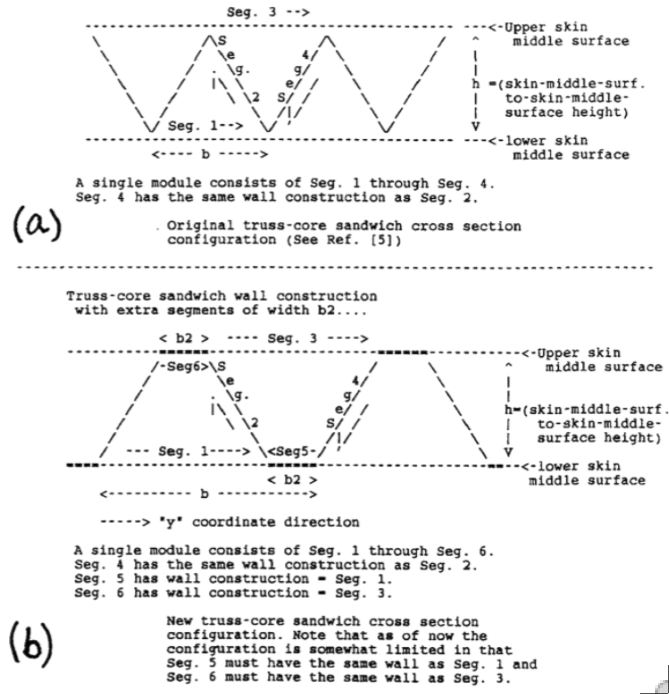
(a) Original truss-core cross-section geometry; (b) New alternative truss-core cross-section geometry now permitted by PANDA2.
PANDA2 is a computer program for the minimum weight design of stiffened, composite, flat or cylindrical, perfect or imperfect panels and shells subjected to multiple sets of combined in-plane loads, normal pressure, edge moments, and temperature. The panels can be locally post-buckled. Recent additions to PANDA2 include implementation of: Sanders-type shell equations as a user-specified choice in addition to the Donnell equations, a 'global' optimizer processor, SUPEROPT, which in a single long run finds optimum designs from several different starting designs, and Arbocz' (1993) extension of Koiter's (1963) special theory for computation of buckling load factors for perfect anisotropic cylindrical shells and knockdown factors for axisymmetrically imperfect shells. Also incorporated are the ability to handle a new truss-core sandwich configuration and isogrid-stiffened panels and shells. These extensions to PANDA2 are described and examples are given.
-
Approximate Method for the Optimum Design of Ring and Stringer Stiffened Cylindrical Panels and Shells with Local, Inter-Ring, and General Buckling Modal Imperfections, D. Bushnell and W. D. Bushnell, Department 93-30, Building 255, Lockheed Palo Alto Research Laboratory, 3251 Hanover St., Palo Alto, CA 94304 USA. Computers & Structures, Vol. 59, No. 3, pp. 489 – 527, 1996.
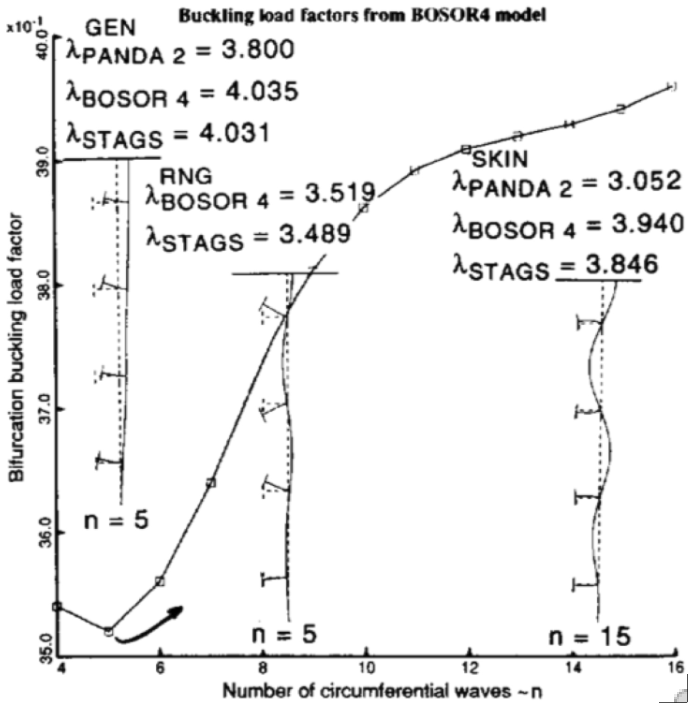
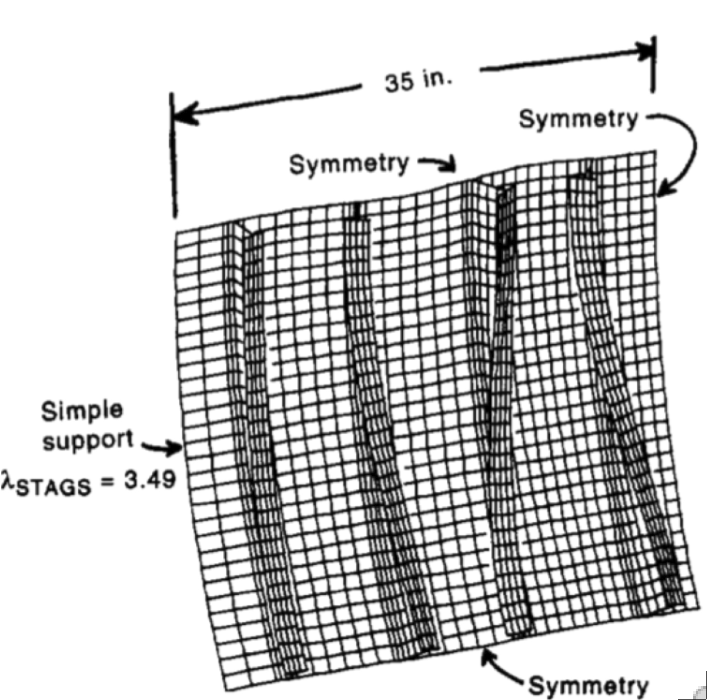
Left: Buckling mode shapes predicted by BOSOR4 and buckling load factors predicted by PANDA2, BOSOR4 and STAGS for the optimized, perfect, internally T-ring-stiffened, 70-inch-long hydrostatically compressed composite cylindrical shell. Right: Ring-tripping buckling mode of the internally T-ring-stiffened, hydrostatically compressed cylindrical shell as predicted by STAGS.
The PANDA2 computer program for minimum-weight design of stiffened composite panels is expanded to handle optimization of ring and stringer stiffened cylindrical panels and shells with three types of initial imperfections in the form of buckling modes, any combination of which may be present: local (buckling between adjacent stringers and rings), inter-ring (buckling between rings with stringers bending with the panel skin), and general (buckling in which both stringers and rings bend with the panel skin). Stresses and buckling load factors of the imperfect panels are computed with use of the assumption that the amplitudes of the buckling modal imperfections grow hyperbolically with increasing load factor according to the formula AMP(i) = EIG(i)/[EIG(i) – 1], in which AMP(i) is a factor to be multiplied by the initial buckling modal imperfection and EIG(i) represents the critical load factor for the ith type of buckling mode (i = 1 = local buckling, i = 2 = inter-ring buckling, i = 3 = general buckling). Buckling load factors corresponding to local, inter-ring, and general buckling of the imperfect panel are computed with use of the maximum radius of curvature that develops in whatever portion of the panel (between stiffeners, inter-ring, overall) is being considered in the calculations and including redistribution of stress resultants over panel skin and stiffener cross-sections caused by prebuckling bending. Stress constraints in the optimization problem are computed including local, inter-ring, and general bending stresses generated by the growth of the initial local, inter-ring, and general imperfections. These bending stresses are added to the stresses from other sources (thermal, in-plane loading, normal pressure, curing, redistribution of membrane stresses from overall prebuckling bending of the imperfect panel). Minimum-weight designs for various imperfect unstiffened and stiffened cylindrical shells derived by PANDA2 are evaluated with use of the STAGS general-purpose finite element code. The agreement of results from PANDA2 and STAGS appears to qualify PANDA2 for the preliminary design of imperfect, stiffened, composite cylindrical shells.
-
Optimization of Stiffened Panels in Which Mode Jumping Is Accounted for, David Bushnell, Charles C. Rankin Department HI-31, Building 255, Lockheed-Martin Palo Alto Research Laboratory 3251 Hanover St., Palo Alto, California 94304 USA, and Eduard Riks, Aerospace Engineering Department, Delft University of Technology, The Netherlands. AIAA 38th Structures, Structural Dynamics and Materials Conference, AIAA Paper 97-1141, 1997.
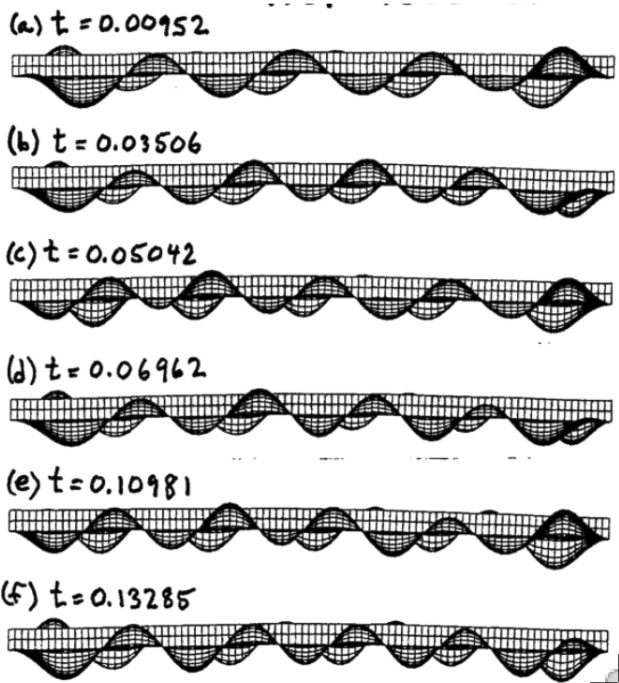
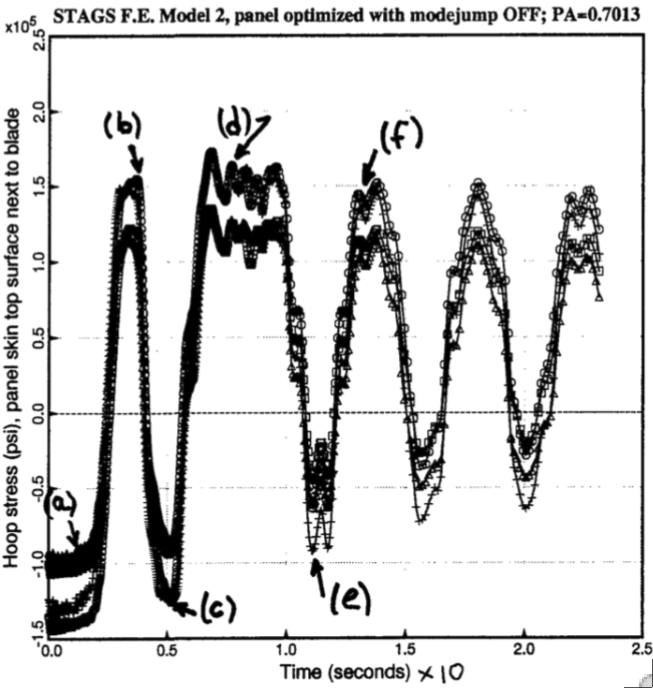
Left: Edge-on view of post-buckled PANEL I during STAGS transient phase at constant load factor, PA=0.7013. The transient behavior is characterized primarily by the buckling waves sliding to and fro along the axis of the blade-stiffened panel. Each frame corresponds to a peak value of hoop stress in the figure on the Right. Right: Oscillations of the maximum hoop stress during the transient phase of the STAGS analysis (dynamic mode jump). The callouts, (a – f). refer to the edge-on “snapshots” in the figure on the Left.
PANDA2 is a computer program for the minimum weight design of stiffened composite, flat or cylindrical, perfect or imperfect panels and shells subject to multiple sets of combined in-plane loads, normal pressure, edge moments and temperature. STAGS is a general nonlinear finite element code that is specifically designed to analyze especially difficult stability problems in shell structures. Weight optimization of stiffened panels can be particularly troublesome when local buckling is allowed to occur in the pre-collapse state. For these systems, designs may be affected by interaction between local modes, a mechanism that manifests itself as mode jumping and is difficult to characterize. In this paper we describe how in PANDA2 mode jumping is detected and suppressed in optimized panels. Two axially compressed blade stiffened panels optimized by PANDA2 for service in the far post-buckling regime were numerically tested by STAGS. Mode jumping was permitted to occur below the design load in the first panel and suppressed in the second. Results obtained by STAGS are in reasonably good agreement with predictions by PANDA2. The first panel exhibits mode jumping well below the design load. Application of STAGS to this panel reveals that even though the mode jump involves little change in potential energy, it generates large amplitude oscillating stresses with significant stress reversal that might well cause fatigue and delamination. The oscillating stresses are caused by post-buckling lobes moving to and fro along the panel axis immediately after initiation of the mode jump.
-
Optimum Design Via Panda2 of Composite Sandwich Panels with Honeycomb or Foam Cores, David Bushnell, Senior Consulting Scientist (Semi-Retired), Department HI-31, Building 255, Lockheed-Martin Palo Alto Research Laboratory, 3251 Hanover St., Palo Alto, California 94304 USA. AIAA 38th Structures, Structural Dynamics and Materials Conference, AIAA Paper 97-1142, 1997.
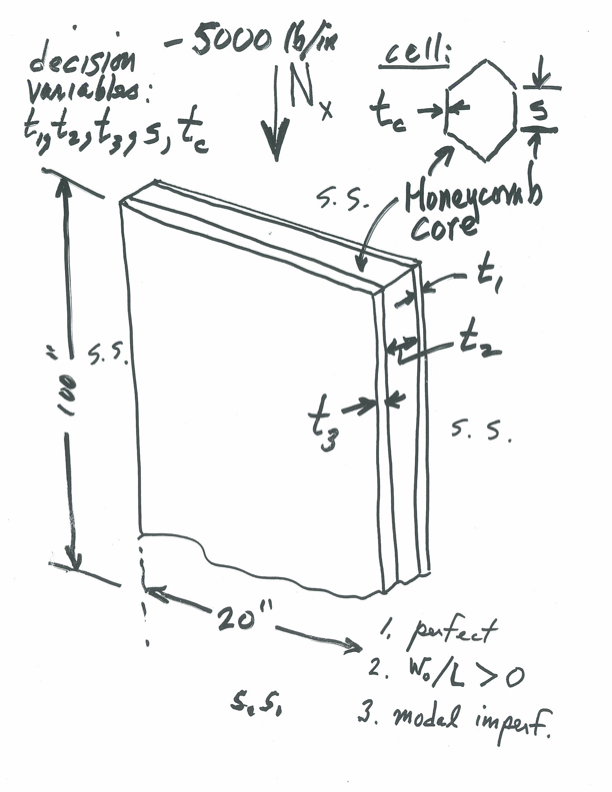
Left: Honeycomb sandwich panel with the identification of decision variables for minimum-weight optimization; Right: Types of failure included in the PANDA2 model that generate design margins during optimization cycles.
PANDA2 has been extended to handle panels with sandwich wall construction by inclusion of the following failure modes in addition to those previously accounted for: (1) face wrinkling, (2) face dimpling, (3) core shear crimping, (4) core transverse shear stress failure, (5) core crushing and tension failure, and (6) face sheet pull-off. Transverse shear deformation effects are included both for overall panel buckling and for local face sheet dimpling and face sheet wrinkling. The new PANDA2 code will optimize stiffened sandwich panels in which the stiffener segments as well as the panel skin may have sandwich wall construction. The effects of panel buckling modal initial imperfections as well as initial face sheet waviness are accounted for during optimization cycles. The updated PANDA2 code will also handle optimization of a panel supported by an elastic Winkler foundation. Examples are presented for a uniformly axially compressed perfect and imperfect unstiffened panel without and with a uniform temperature gradient through the panel wall thickness. Initial face sheet waviness and initial overall buckling modal imperfections both have major influence on optimum designs of sandwich panels with honeycomb cores.
-
Optimization of Panels with Riveted Z-Shaped Stiffeners Via Panda2, David Bushnell, Semi-Retired, formerly with Dept. HI-61, Bldg.250 Lockheed Martin Advanced Technology Center, 3251 Hanover St., Palo Alto, California 94304 USA. AIAA 39th Structures, Structural Dynamics and Materials Conference, AIAA Paper 98-1990, 1998.
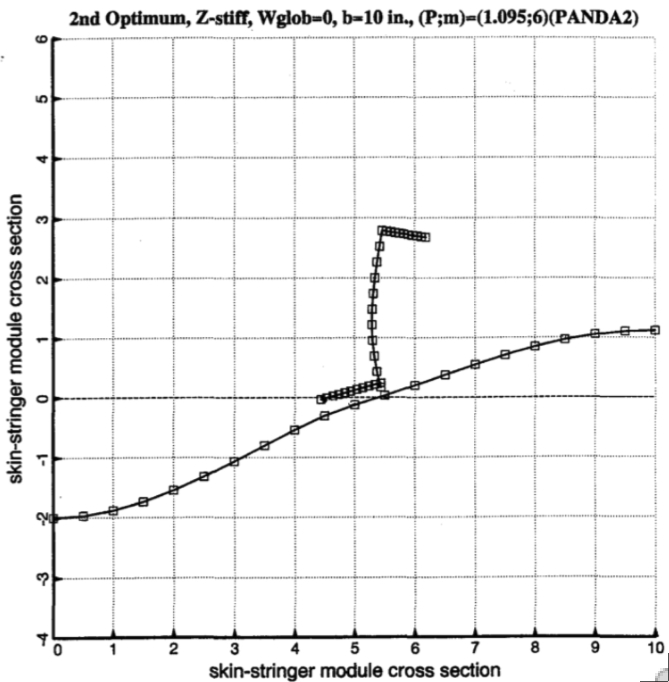
Local skin buckling mode of an axially compressed optimized panel with riveted Z-shaped stringers. The stringer spacing is 10 inches. Notice that there is considerable deformation of the web of the Z-shaped stringer in the local buckling mode shape. This web deformation has a significant effect on the local buckling load factor. A model in which the Z-shaped stringer is treated as a discrete ring with a non-deformable cross section would yield a significantly higher local buckling load factor than 1.095. An analogous local deformation of the faying flange and web of a Z-shaped stringer occurs also in the critical general buckling mode shape and has a similar significant effect on the general buckling load factor. This effect is convincingly demonstrated by the 1975 theoretical and experimental results of Heard, Anderson and Stephens, shown in the three slides related to the buckling under uniform external pressure of a Z-ring stiffened shallow conical shell presented on the website page, Buckled Shells.
The PANDA2 computer program has been modified to permit minimum weight design of imperfect panels with riveted Z-shaped stiffeners for service in a load regime in which the panel is in its locally post-buckled state. Perfect and imperfect panels optimized with PANDA2 are evaluated via nonlinear STAGS analyses. The agreement between predictions by PANDA2 and STAGS is sufficient to qualify PANDA2 as a preliminary design tool for panels with riveted Z-shaped stringers. Optimum designs for panels with Z-shaped stringers are compared to those with J-shaped and T-shaped stringers.
-
Additional Buckling Solutions in Panda2, David Bushnell, Senior Staff Scientist, Semi-Retired, Dept. HI-61, Bldg. 250, Lockheed Martin Advanced Technology Center, 3251 Hanover St., Palo Alto, California 94304 USA and Hao Jiang , Graduate Student, and Norm F. Knight, Jr., Professor Aerospace Engineering Department, Old Dominion University, Norfolk, Virginia. AIAA 40th Structures, Structural Dynamics and Materials Conference, AIAA Paper 99-1233, 1999.
A double trigonometric series expansion representation of the buckling modal displacements, u, v and w, was added to the “stable” of buckling models used in PANDA2.
Three new buckling models have been incorporated into PANDA2, a program for minimum weight design of stiffened composite panels and shells: (1) buckling of unstiffened panels or unstiffened portions of panels with use of double-trigonometric series expansions for buckling modal displacement components, u, u, w; (2) general buckling of cylindrical, stiffened panels with both rings and stringers treated as discrete beams; and (3) inter-ring buckling of cylindrical panels based on a discretized single module model containing discretized ring segments and a discretized skin-smeared-stringer cylindrical surface to which the ring is attached. Examples are provided of buckling of certain isotropic and laminated composite flat and cylindrical unstiffened and stiffened panels and shells for which the predictions from the modified PANDA2, formerly unacceptably inaccurate, are compared with predictions from STAGS, a general-purpose finite element code. The new comparisons demonstrate that the modified PANDA2 is now well qualified for preliminary design in particular cases for which it previously yielded unreliable designs and designs that were overly conservative. The optimum design of a composite ring and stringer stiffened cylindrical shell derived by PANDA2 is evaluated with use of STAGS. The optimum design of an isotropic hydrostatically compressed internally T-ring stiffened cylindrical shell optimized by PANDA2 is evaluated with use of the shell-of-revolution code BOSOR4. There is good agreement between PANDA2 predictions and STAGS and BOSOR4 predictions for buckling of the optimized designs. (2011 NOTE: BOSOR4 has been superseded by BIGBOSOR4, which handles many more shell segments.)
Abstracts and Papers (2002-2007)
-
Global Optimum Design of Externally Pressurized Isogrid Stiffened Cylindrical Shells with Added T-Rings, David Bushnell, Semi-Retired from Department L9-24, Building 204, Lockheed Martin Advanced Technology Center, 3251 Hanover St., Palo Alto, CA 94304-1911, USA. International Journal of Non-Linear Mechanics, 37 (2002) 801–831.
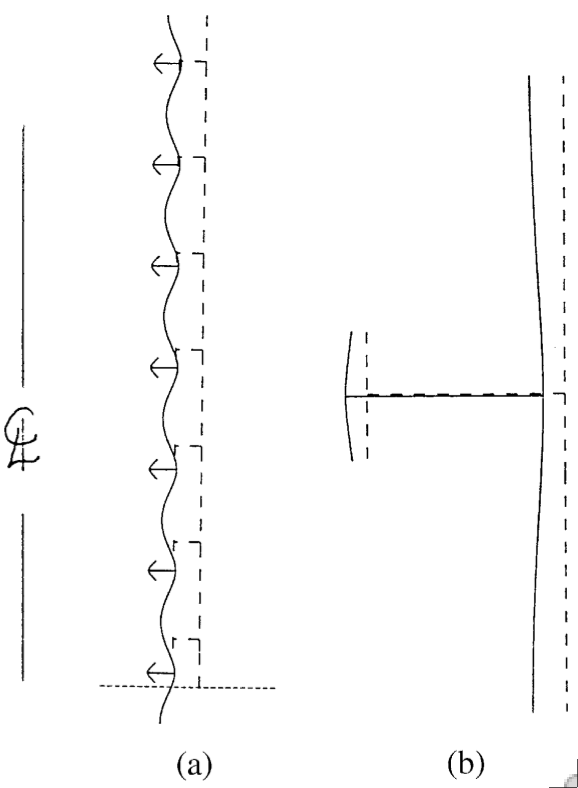
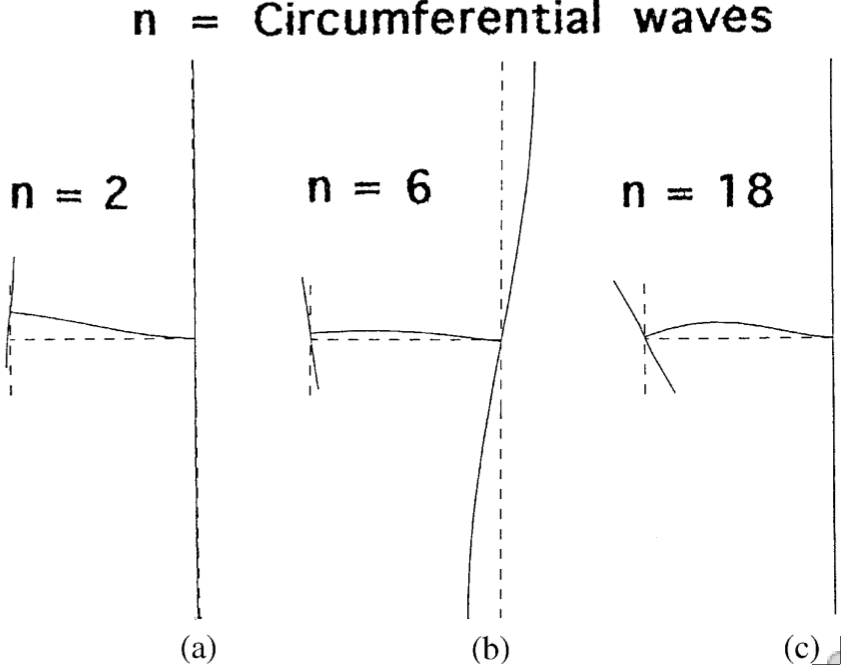
Left: Axisymmetric prebuckling deformation of an optimized internally T-ring-stiffened cylindrical shell under uniform external pressure - (a) Several ring bays; (b) One ring bay with mid-bay symmetry conditions imposed between adjacent rings. Right: Non-axisymmetric bifurcation buckling modes accounted for during optimization cycles – (a) Low-n T-ring sidesway; (b) Mid-n local skin buckling between rings including some deformation of the web of the T-ring; (c) High-n crippling of the web of the T-ring with negligible participation of the skin of the cylindrical shell.
PANDA2 is a code for the minimum-weight design of perfect and imperfect elastic stiffened panels and shells made of composite laminates and subjected to multiple sets of in-plane loads, edge moments, normal pressure, and temperature. The scope of PANDA2 is increased to include global optimization and the capability to handle isogrid stiffening. The enhanced program is used to find global optimum designs of internally T-isogrid and internally T-ring stiffened perfect and imperfect isotropic cylindrical shells under uniform external pressure. For the cases studied, it is found that for the perfect optimized shells the isogrid stiffening is important but the rings are not, whereas the opposite holds for the optimized shells with an initial general buckling modal imperfection of amplitude equal to one per cent of the shell radius.
-
Optimization of Perfect and Imperfect Ring and Stringer Stiffened Cylindrical Shells with PANDA2 and Evaluation of the Optimum Designs with STAGS, David Bushnell, Fellow, AIAA, Semi-Retired and Charles Rankin, Associate Fellow, AIAA, Lockheed Martin Advanced Technology Center Dept. L9-21, Bldg. 204, 3251 Hanover St., Palo Alto, CA 94304-1911, USA. AIAA 43rd Structures, Structural Dynamics and Materials Conference, AIAA-2002-1408, 2002.

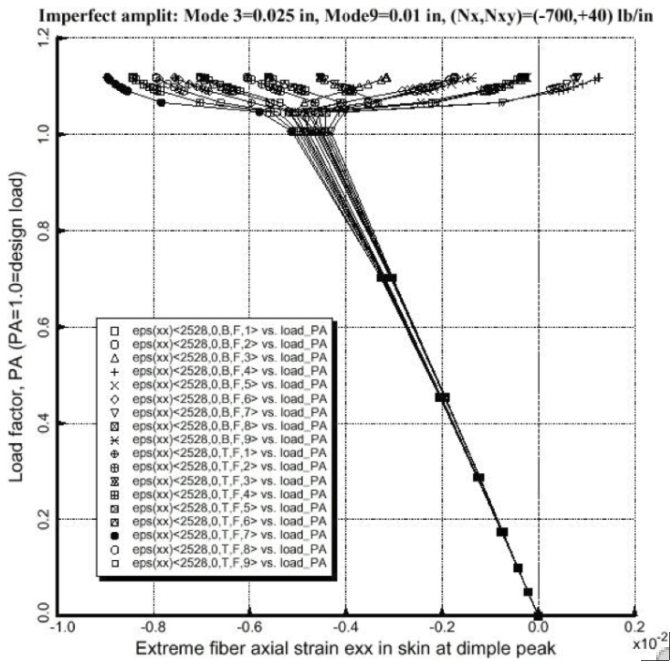
Top: Collapse mode predicted by STAGS of a previously optimized cylindrical shell stiffened by external blade stringers and internal blade rings and subjected to combined axial loading and torque. Bottom: Extreme inner and outer fiber axial strain in the skin of the cylindrical shell at a dimple (post-buckled peak) located where the finite element mesh is the densest.
Ring and stringer stiffened perfect and imperfect angle-ply cylindrical shells under combined axial compression and in-plane shear are optimized with a program called PANDA2 for the minimum weight design of stiffened panels, and the optimum designs are then evaluated with use of a general-purpose finite element code called STAGS. The good agreement between PANDA2 and STAGS predictions for the nonlinear collapse of imperfect stiffened shells justifies the use of PANDA2 for preliminary design. A new PANDA2 processor called STAGSUNIT automatically generates STAGS input files for cylindrical panels and shells with both stringers and rings that have various open cross sections such as Blades, Zees, Jays, Tees and Is. In STAGSUNIT the edge conditions are formulated so that STAGS models of sub-domains of a long cylindrical shell with many stiffeners can be constructed that do not have artificial pre-buckling stress concentrations near the edges that might significantly affect predictions of bifurcation buckling and nonlinear collapse of the sub-domain. Many STAGS models of optimized shells and sub-domains of shells with Blade, Zee, and Tee stiffening are generated and explored, both with respect to linear bifurcation buckling and nonlinear collapse. The behavior of shells with an initial imperfection in the form of a general buckling mode of the imperfect shell is described from a physical point of view. Some difficulties encountered during this project are described.
-
Optimum Design of Stiffened Panels with Substiffeners, David Bushnell, Fellow, AIAA, Semi-Retired, and Charles Rankin, Associate Fellow, AIAA, Rhombus Consultants Group, Inc. Suite B100, 1121 San Antonio Rd., Palo Alto, CA 94303 USA. AIAA 46th Structures, Structural Dynamics, and Materials Conference, AIAA-2005-1932, 2005.
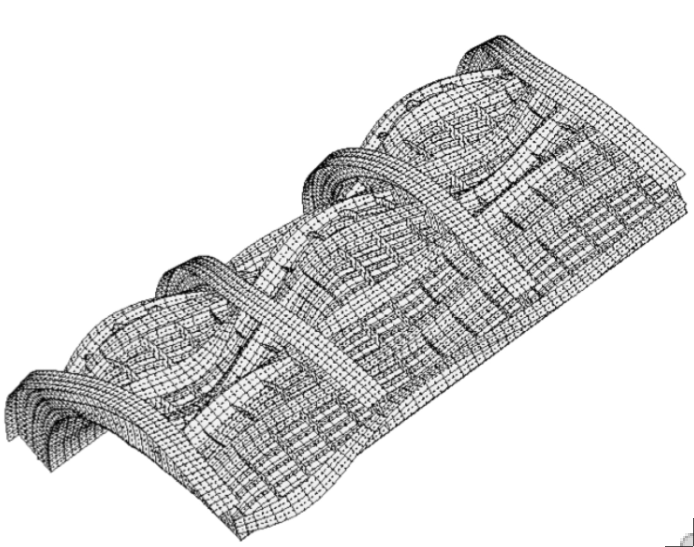
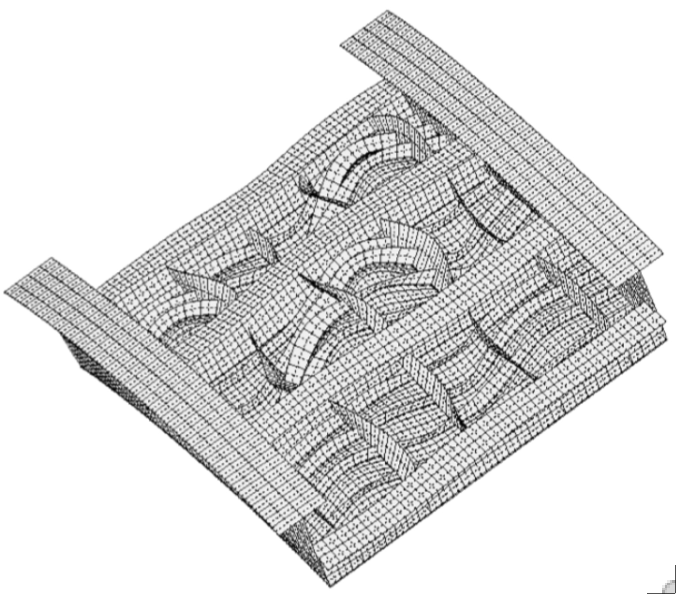
Left: Inter-ring buckling mode predicted by STAGS for three axial bays and nine circumferential bays of a previously optimized complete cylindrical shell under combined axial compression, external pressure and in-plane shear. The cylindrical shell is stiffened by external T-shaped major stringers and external T-shaped major rings plus blade-shaped external sub-stringers and external sub-rings. Right: Local buckling of both skin and sub-stiffeners between major stringers and major rings.
The capability of the computer program PANDA2 to generate minimum-weight designs of stiffened panels and cylindrical shells is enhanced to permit the adding of sub-stiffeners with rectangular cross sections between adjacent major stringers and major rings. As a result many new buckling margins exist that govern buckling over various domains and sub-domains of the doubly stiffened panel or shell. These generally influence the evolution of the design during optimization cycles. The sub-stiffeners may be stringers and/or rings or may form an isogrid pattern. The effects of local, inter-ring, and general buckling modal imperfections can be accounted for during optimization. Perfect and imperfect cylindrical shells with external T-shaped stringers and T-shaped rings and with and without sub-stringers and sub-rings and under combined axial compression, external pressure, and in-plane shear are optimized by multiple executions of a "global" optimizer called SUPEROPT. It is found that from the point of view of minimum weight there is little advantage of adding sub-stiffeners. However, with sub-stiffeners present the major stringers and rings are spaced farther apart at the optimum design than is so when there are no sub-stiffeners. The weight of a cylindrical shell with sub-stiffeners is much less sensitive to the spacing of the major T-shaped stringers than is the case for a cylindrical shell without sub-stiffeners. The optimum designs obtained by PANDA2 are evaluated by comparisons with buckling loads obtained from a general-purpose finite element program called STAGS. Predictions from STAGS agree well with those from PANDA2.
-
Difficulties in Optimization of Imperfect Stiffened Cylindrical Shells, David Bushnell, Fellow, AIAA, Semi-Retired, and Charles Rankin, Associate Fellow, AIAA, Rhombus Consultants Group, Inc. Suite B100, 1121 San Antonio Rd., Palo Alto, CA 94303 USA. AIAA 47th Structures, Structural Dynamics, and Materials Conference, AIAA-2006-1943, 2006.
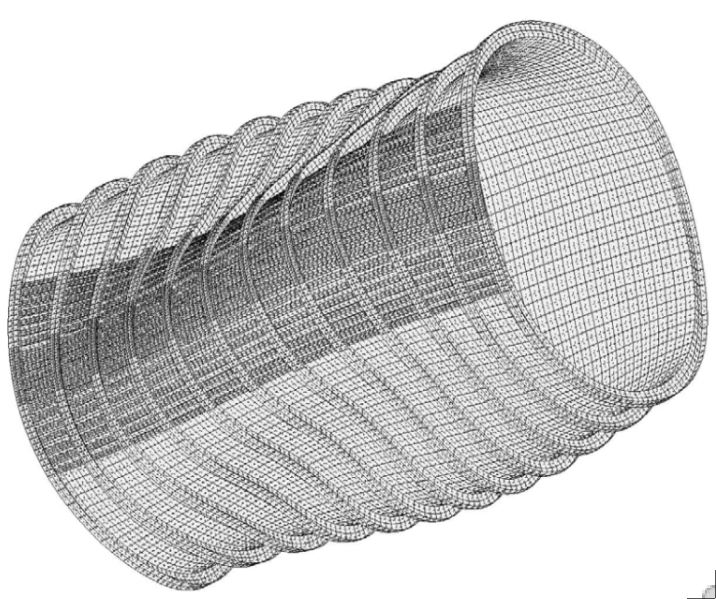
General buckling from a STAGS model of a previously optimized, externally T-ring and T-stringer stiffened cylindrical shell under combined axial compression, external pressure and torque. This buckling mode shape is used as an initial imperfection shape in a following nonlinear equilibrium analysis by STAGS.
The PANDA2 computer program generates minimum-weight designs of ring and stringer stiffened flat or cylindrical composite panels subjected to multiple sets of load combinations. PANDA2 is described with emphasis on the many different stress and buckling constraints that can affect the evolution of a design during optimization cycles, on the way that imperfections are treated, on certain difficulties that imperfections may cause during optimization cycles, and on difficulties encountered during attempts to evaluate optimum designs with the use of the STAGS general purpose finite element program. Details are given on how PANDA2 determines the effect of an initial buckling modal imperfection on the load-bearing capability of a ring and stringer stiffened cylindrical shell. Numerical results pertain to a metallic cylindrical shell with external T-shaped stringers and external T-shaped rings subjected to combined axial compression, external pressure and in-plane shear (torque). The maximum allowable stress is set very high so that stress constraints do not affect the evolution of the global optimum design in this example. Minimum-weight designs are determined for this shell with an initial imperfection in the form of the critical general buckling mode. Modifications to PANDA2 are described that overcome some of the difficulties associated with the determination of a global optimum design in the presence of an initial general buckling modal imperfection. Further modifications to PANDA2 are described that lead to less conservative global optimum designs than was previously the case. The optimum designs obtained by PANDA2 are evaluated by comparisons with predictions from STAGS for various finite element models generated automatically with a PANDA2 processor called STAGSUNIT. The agreement between PANDA2 and STAGS predictions for a global optimum design obtained by PANDA2 is good enough to qualify PANDA2 for the optimum design of imperfect stiffened cylindrical panels and shells under combined loads.
-
Optimization of an Axially Compressed Ring and Stringer Stiffened Cylindrical Shell with a General Buckling Modal Imperfection, David Bushnell, Fellow, AIAA, Semi-Retired. AIAA 48th Structures, Structural Dynamics, and Materials Conference, AIAA-2007-2216, 2007.

STAGS model of a previously optimized, externally T-stringer and internally T-ring stiffened, imperfect cylindrical shell subjected to uniform axial compression, Nx. Shown here is the stress distribution (psi) in the skin and stiffeners of the optimized shell as loaded by the design load. Pre-buckling bending of the imperfect shell causes redistribution of stresses among the shell skin and stiffener segments. Also, pre-buckling bending gives rise to “flattened” regions with an “effective” circumferential radius of curvature greater than nominal that causes early general buckling.
- Long abstract
- Full paper
- PowerPoint Presentation
- Table of Optimum designs from PANDA2 suitable for analysis by STAGS (dimensions in inches)
- Two major effects of a general buckling modal imperfection
PANDA2, a computer program for the minimum-weight design of elastic perfect and imperfect stiffened cylindrical panels and shells under multiple sets of combined loads, is used to obtain optimum designs of uniformly axially compressed elastic internal T-ring and external T-stringer stiffened cylindrical shells with initial imperfections in the form of the general buckling mode. The optimum designs generated by PANDA2 are verified by STAGS elastic and elastic-plastic finite element models produced automatically by a PANDA2 processor called STAGSUNIT. Predictions from STAGS agree well with those from PANDA2. Improvements to PANDA2 during the past year are summarized. Seven different optimum designs are obtained by PANDA2 under various conditions. The most significant condition is whether or not PANDA2 is permitted automatically to make the initial user-specified amplitude of the general buckling modal imperfection directly proportional to the axial half-wavelength of the critical general buckling mode. A survey is conducted over (m,n) space to determine whether or not the critical general buckling modal imperfection shape computed by PANDA2 with (m,n) critical (m=axial, n=circumferential) half-waves is the most harmful imperfection shape. It is found that indeed (m,n) critical is, for all practical purposes, the most harmful imperfection mode shape if PANDA2 is permitted automatically to make the general buckling modal imperfection amplitude directly proportional to the axial half-wavelength of the critical general buckling mode (inversely proportional to m). It is concluded that for axially compressed, stiffened, globally imperfect cylindrical shells the optimum designs obtained with the condition that PANDA2 is NOT allowed to change the initial user-specified imperfection amplitude are probably too heavy. One of the cases investigated demonstrates that the optimum design of a perfect shell obtained via the commonly used condition that a likely initial imperfection be replaced by an increase in the applied load by a factor equal to the inverse of a typical knockdown factor is too heavy. A new input index, ICONSV, is introduced into PANDA2 by means of which optimum designs of various degrees of conservativeness can be generated. Optimum designs are obtained with ICONSV = -1, 0, and +1, which represent increasing degrees of conservativeness in the PANDA2 model. It is concluded that, when obtaining optimum designs with PANDA2, it is best to allow PANDA2 to enter its branch in which local post-buckling behavior is determined, thereby avoiding the generation of designs that may be unsafe because of excessive local bending stresses in the panel skin and stiffener parts. In most cases both nonlinear static and nonlinear dynamic analyses are required in order to obtain collapse loads with STAGS. A table is included that demonstrates how to use STAGS to evaluate an optimum design obtained by PANDA2. In most cases the elastic STAGS models predict collapse in one of the ring bays nearest an end of the cylindrical shell. With the effect of elastic-plastic material behavior included in the STAGS models, collapse most often occurs in an interior ring bay where the finite element mesh is the densest.
Unpublished Papers
-
The Introduction of Cold-Bending Ring Buckling Margins into PANDA2, David Bushnell, Fellow, AIAA, Semi-Retired. Unpublished work, April 2009.
Often cylindrical shells are fabricated by cold bending a flat plate or sheet into a cylindrical form. NASA fabricates some lightweight stiffened cylindrical shells with use of the following steps:
- A regular array of "pockets" is "hogged out" of a rather thick flat plate. The "hogged out" flat plate is then a "stiffened" flat plate, with the stiffeners (stringers and rings) being the thicker material between the "pockets".
- The "hogged out" plate is then cold bent into a cylindrical shell, or rather into a part of a cylindrical shell, say a panel subtending 120 degrees or something like that. The cold-bending is applied usually with the stiffeners on the inside. In this process the plate is bent into a radius, call it "RCOLD", which is smaller than the design radius. Call that "RCYL". Upon elastic spring-back the final radius should be close to RCYL.
- An annealing process is applied to the cold-bent cylindrical panel.
- A number of cylindrical panels fabricated in this way are welded together to form a complete (360-degree) cylindrical shell.
This news item is concerned with Step 2. The question arises, "How can the designer determine the best 'slenderness' (height-to-thickness ratio) of the rings, which experience potentially destabilizing hoop compression during the cold-bending process?"
-
Additional PANDA2 documents
